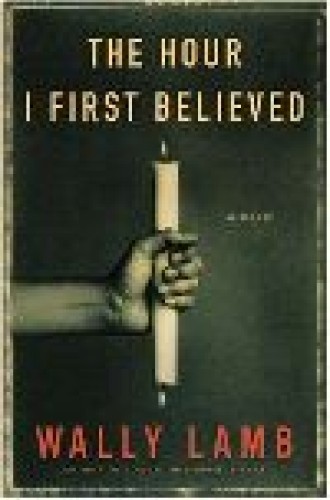The Hour I First Believed
Wally Lamb has a thing for lyrics. His own prose isn’t very musical—it clunks along like a muffler about ready to fall from an old Ford—but over and over again his characters find something they need in popular songs. His first novel, She’s Come Undone, took its title from the Guess Who and went on to play a veritable jukebox. His second, I Know This Much Is True, evoked a tune by Spandau Ballet. In his latest novel, the narrator spends hours replaying favorite songs in his head. Other characters can’t get away from them either: one complains that she was “named after some stupid song on the radio.” These characters come with a soundtrack, and they can’t turn it off.
Depending on your taste, this demonstrates either Lamb’s relevance or his limitations as an artist. His characters don’t find new ways to express themselves—they just sound like us, word for clumsy word.
But their stories are sensational, ripe for a talk show. They suffer abuse, abandonment, mental illness, self-mutilation, rape. The last time that serious fiction saw so many victims, John Irving was blinding them, unmanning them and cutting out their tongues before permitting them some kind of redemption.
This is a long book about the Columbine massacre, Iraq, Katrina, infidelity, incarceration, emotional collapse, buried family secrets—a gothic novel on steroids that comes to a curious end with a quote from “Amazing Grace.” None of Lamb’s books is economical, but he has managed here to paint so sweeping a picture of American dysfunction that the reader may be numbed. And he pads it with an afterword, acknowledgments and lists of sources and suggested charities.
Whether or not Lamb is a skillful writer, plainly he understands and loves damaged people. Caelum Quirk, the narrator and stand-in for Lamb himself, comes off as a quirky antihero, a teacher who has a lot to learn. He’s nursing a grudge against his wife, Maureen, for an affair—until she winds up in the horror of Columbine. Bringing her back home to Connecticut doesn’t forestall her descent into depression and addiction to painkillers. Then she accidentally kills a boy and is sent to a prison founded (believe it or not) by Caelum’s great-grandmother. As if that weren’t coincidence enough, Caelum discovers that his grandmother and mother also were inmates of the Quirk Correctional Institute. Along the way he forges a makeshift family with Janis Mick (not hard to guess where her names come from) and a runaway named Velvet Hoon (the Velvet Underground, I suppose). As in the second novel, a psychologist named Dr. Patel helps the narrator to fit together the pieces of a fractured identity. Everyone here is damaged—which helps them have an uneasy empathy for Eric Harris and Dylan Klebold, the Columbine killers.
Lamb wants to draw parallels between recent national tragedies and buried American anger, to connect the dots between victims of one era and victims of another. These big statements might not come off, but his love for these characters is convincing. It shows in the little details—the clumsy jokes, the down-market appetites that make them come alive. The characters love one another in spite of themselves, and they find their way back to one another heroically.
Appropriately, one of the central metaphors of the novel is the Minotaur in the labyrinth, the beast that must be slain so a cycle of violence can be brought to an end. Like Theseus with Ariadne’s thread, Caelum tries not to lose his way while following clues through his own troubled history. Other characters see themselves as opening Pandora’s box or falling like Icarus from the sky. One really wouldn’t call these allusions, for Lamb makes the parallels explicit. Caelum even tells his students how he and his wife resemble Orpheus and Eurydice. “That’s the one where the dude goes down to Hell to get his wife back,” a student nods. “Then he forgets he’s not supposed to look back at her while she’s following him out, so she has to stay.” So we know where that plotline is headed.
Long before the hour he first believes, Caelum wrestles with life’s seeming randomness. The chaos of Columbine, which sets in motion troubles and more troubles, puts him in mind of chaos theory and the idea that a butterfly can stir a tropical storm. Meanwhile, he also keeps seeing a praying mantis, which represents the possibility of, well, something more prayerful. These deeply dysfunctional characters fumble toward faith, seeking symbolism even in insects, because they need God so much.
Out of the low moments, Lamb brings about epiphanies and redemption. At one point, Caelum declares:
There is no mysterious Master Plan ner, no one up there who can see the big picture—the order in the disorder. Religion’s just a well-oiled, profit-driven denial of the randomness of it all. That’s what I’ve come to believe.
By the end of the novel, Caelum sees things differently. All the preposterous coincidences of Lamb’s plot suggest anything but randomness. He has woven themes, symbols and characters together with contrivances that would make Dickens blush.
Just how The Hour I First Believed earns its title is hard to say. Very little of the book explicitly concerns religious faith. And when in the closing pages Caelum describes his 12-step program, his affirmation of a higher power is so utterly conventional that a reader may wonder why it took 700 pages to get there. Lamb lays out his own beliefs in an afterword. “We are all responsible for one another,” he says—a spiritual, nonreligious, vaguely political assertion that pretty well captures the pain and the hope in all his work.
For all Lamb’s talk of chaos, his fiction has settled into a recognizable pattern. My guess is that when he brings out his fourth novel, we can expect more mystical yearning, more crunching guitar chords, and maybe a title from Led Zeppelin: The Song Remains the Same.






